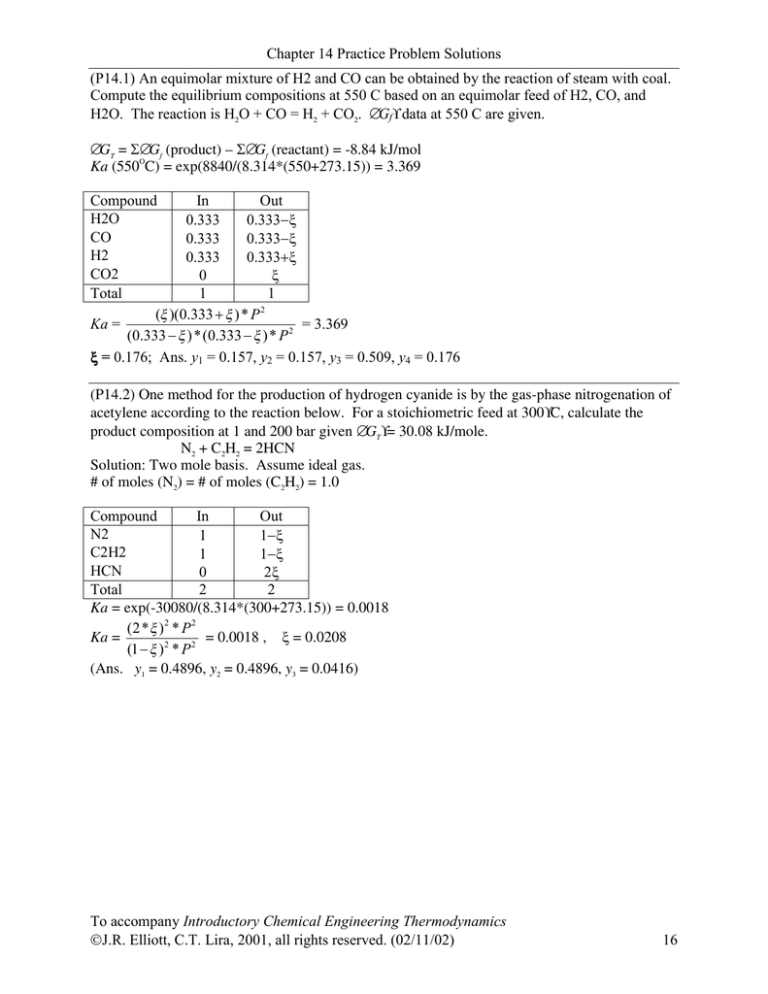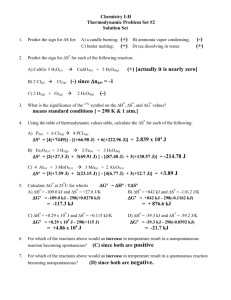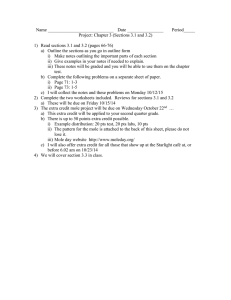
Chapter 14 Practice Problem Solutions
(P14.1) An equimolar mixture of H2 and CO can be obtained by the reaction of steam with coal.
Compute the equilibrium compositions at 550 C based on an equimolar feed of H2, CO, and
H2O. The reaction is H2O + CO = H2 + CO2. ∆Gf° data at 550 C are given.
∆GT = Σ∆Gf (product) Σ∆Gf (reactant) = -8.84 kJ/mol
Ka (550OC) = exp(8840/(8.314*(550+273.15)) = 3.369
Compound
In
Out
H2O
0.333
0.333−ξ
CO
0.333
0.333−ξ
H2
0.333
0.333+ξ
CO2
0
ξ
Total
1
1
2
(ξ )(0.333 + ξ ) * P
= 3.369
Ka =
(0.333 − ξ ) *(0.333 − ξ )* P 2
ξ = 0.176; Ans. y1 = 0.157, y2 = 0.157, y3 = 0.509, y4 = 0.176
(P14.2) One method for the production of hydrogen cyanide is by the gas-phase nitrogenation of
acetylene according to the reaction below. For a stoichiometric feed at 300°C, calculate the
product composition at 1 and 200 bar given ∆GT°= 30.08 kJ/mole.
N2 + C2H2 = 2HCN
Solution: Two mole basis. Assume ideal gas.
# of moles (N2) = # of moles (C2H2) = 1.0
Compound
In
Out
N2
1
1−ξ
C2H2
1
1−ξ
HCN
0
2ξ
Total
2
2
Ka = exp(-30080/(8.314*(300+273.15)) = 0.0018
(2* ξ ) 2 * P 2
Ka =
= 0.0018 , ξ = 0.0208
(1 − ξ )2 * P 2
(Ans. y1 = 0.4896, y2 = 0.4896, y3 = 0.0416)
To accompany Introductory Chemical Engineering Thermodynamics
J.R. Elliott, C.T. Lira, 2001, all rights reserved. (02/11/02)
16
Chapter 14 Practice Problem Solutions
(P.14.3) Butadiene can be prepared by the gas-phase catalytic dehydrogenation of 1-Butene:
C4H8 = C4H6 + H2. In order to suppress side reactions, the butene is diluted with steam before
it passes into the reactor.
(a) Estimate the temperature at which the reactor must be operated in order to convert 30% of
the 1-butene to 1,3-butadiene at a reactor pressure of 2 bar from a feed consisting of 12 mol
of steam per mole of 1-butene.
(b) If the initial mixture consists of 50 mol% steam and 50mol% 1-butene, how will the required
temperature be affected?
600K
700K
800K
900K
∆Gf°
C4H6
195.73
211.71
227.94
244.35
C4H8
150.92
178.78
206.89
235.35
Solution:
Compound
In
Out
C4H8
1
1-ξ
C4H6
0
ξ
H2
0
ξ
H2O
12
12
Total
13
13+ξ
P = 2 bar
0.001
2
ξ
2
13 + ξ * P
ξ2 *P
=
Ka =
1− ξ
(13 + ξ ) * (1 − ξ )
13 + ξ P
Compound
C4H8
C4H6
H2
H2O
Total
In
1
0
0
1
2
Out
1-ξ
ξ
ξ
1
2+ξ
0.0014
0.0016
0.0018
-1
-2
-3
-4
ln Ka
Ka = 0.01933
Noting that lnKa = -∆Gtot/RT, we can
identify the temperature by fitting a
trendline to the given data.
⇒ ln 0.01933 = -3.95,
substitute in the equation of straight line,
⇒
x = -(-14.34 – 3.95 )/13996.
⇒ x = 0.001306 = 1/T,
⇒ T = 765.22 K = 492OC
0.0012
0
-5
-6
-7
y = -13996x + 14.34
-8
-9
-10
1/T
Ka =
ξ2 *P
= 0.1118
(2 + ξ )* (1 − ξ )
Similarly , T = 846.65K = 573.6 O C
⇒ We need higher T.
To accompany Introductory Chemical Engineering Thermodynamics
J.R. Elliott, C.T. Lira, 2001, all rights reserved. (02/11/02)
17
Chapter 14 Practice Problem Solutions
(P14.4) The standard Gibbs energy change for ethylene oxide at 298K for the reaction is –79.79
kJ/mole. This large negative value of ∆GT° indicates that equilibrium is far to the right at 298K
but what about 550K? Heat capacity expressions are given as CP= a + b T.
Solution: The heat of reaction must be looked up. Referring to Apx E.6 for ethylene and the
DIPPR handbook for ethylene oxide, ∆H298° = -52.6-52.51 = -105.1 kJ/mol. Following Eqs.
14.28 and 14.30,
-105100 = J + (6.57-15.4-26.65/2) 298 + (0.1389-0.0937-0.00845/2) 2982/2
-105100 = J – 22.155 *298 + 0.040975*2982/2 ⇒ J =-100317 J/mol
-79790/(8.314*298) = -100317/(8.314*298) –
−79790
−100317 −22.155
0.040975
=
−
ln 298 −
298 + I => I = −6.16
8.314* 298 8.314* 298
8.314
2*8.314
∆G o
−100317 −22.155
0.040975
ln 550 −
550 + 6.16 = 12.6
=
−
8.314*550 8.314*550
8.314
2*8.314
⇒ ∆G° = -57.7 kJ/mol. If T = 550 K, increasing T will give an adverse effect on equilibrium,
but the reaction is still very strongly favored and the impact will be indistinguishable.
(P14.5) The “water gas” shift is to be carried out at a specified temperature and pressure
employing a feed containing only CO and H2O. Show that the maximum equilibrium mole
fraction of H2 in the product results when the feed contains CO and H2O in their stoichiometric
proportions. Assume ideal gas behavior.
Solution: CO + H 2 O = CO2 + H 2
Compound
In
Out
ξ2
Ka
=
CO
z
z-ξ
( z − ξ )(1 − ξ )
H2O
1
1−ξ
2
⇒ ξ − Ka ( z − ξ )(1 − ξ ) = 0
CO2
0
ξ
H2
0
ξ
0 = ξ 2 − Ka[ z − (1 + z )ξ + ξ 2 ]
Total
1+z
1+z
2
ξ (1-Ka) +Ka (1+z) ξ - Ka z = 0 ⇒ ξ = {-Ka(1+z) + [Ka2(1+z)2+4z(1-Ka)Ka]1/2 }/[2(1-Ka)]
yH2 = ξ/(1+z) = {-Ka(1+z) + [Ka2(1+z)2+4z(1-Ka)Ka]1/2 }/[2(1+z)(1-Ka)]
yH2 = ξ/(1+z) = {-Ka+ [Ka2+4z(1-Ka)Ka/(1+z)2]1/2 }/[2(1-Ka)]
To find maximum, take derivative and set equal to zero.
dy/dz = 0.5[Ka2+4z(1-Ka)Ka/(1+z)2]-1/2 [4(1-Ka)Ka/(1+z)2 – 8z(1-Ka)Ka/(1+z)3] = 0
1 = 2z/(1+z) ⇒ z = 1. QED.
(P14.6) Assuming ideal gas behavior, estimate the equilibrium composition at 400K and 1 bar of
a reactive mixture containing the three isomers of pentane. Formation data are given at 400K.
Solution: This is best solved by the Gibbs minimization method, adapting Example 14.10 and
GibbsMin from the Rxns.xls workbook, we obtain the following.
ni(Gi/RT+lnyi)
yi
Gf(J/mole) Gf400/RT feed
ni
log(ni)
nPentane
40170
12.08
0
0.111
-0.95
0.111
1.100
iPentane
34310
10.32
1
0.648
-0.19
0.648
6.408
neoPentane
37610
11.31
0
0.240
-0.62
0.240
2.376
Tot
1
1.000
9.884
Out
In
C-bal
5
5
Hbal
12
12
To accompany Introductory Chemical Engineering Thermodynamics
J.R. Elliott, C.T. Lira, 2001, all rights reserved. (02/11/02)
18
Chapter 14 Practice Problem Solutions
(P14.7) One method for the manufacture of synthesis gas depends on the vapor-phase catalytic
reaction of methane with steam according to the equation below. The water-gas shift reaction
also is important. Bases on stoichiometric feed of methane and steam, compute the eq
composition at 600K, 1300K and 1, 100 bars.
CH 4 + H 2O = CO + 3H 2
rxn(1)
H 2 O + CO = H 2 + CO2
rxn(2)
Compound
In
Out
CH4
1
1−ξ1
H2O
1
1−ξ1−ξ2
CO
0
ξ1−ξ2
H2
0
3ξ1+ξ2
CO2
0
ξ2
Total
2
2+2ξ1
∆G600 K = −164.68 + 214.01 + 22.97 = 72.3kJ / mole.........................rxn(1)
∆G600 K = −395.14 + 214.01 + 164.68 = −16.45kJ / mole......................rxn(2)
− 72300 J / mole
Ka 600 K ,1 = exp
= 5.08 E − 7
8.314 * 600
16450
Ka 600 K , 2 = exp
= 27.05
8.314 * 600
PP 14.7
(ξ1 − ξ 2 )(3ξ1 + ξ 2 )3 * P 4
4
Two simultaneous reactions:
(2 + 2ξ1 )
Ka1 =
2
CH4 + H2O =CO + 3H2
(1 − ξ1 )(1 − ξ1 − ξ 2 ) * P
2
H2+CO2 = CO + H2O
(2 + 2ξ1 )
(Details of equations described in text)
(ξ1 − ξ 2 )(3ξ1 + ξ 2 )3 * P 2
P(bars)
100
=
(1 − ξ1 )(1 − ξ1 − ξ 2 ) (2 + 2ξ1 )2
T(K)
1300
2
ξ 2 (ξ1 + ξ 2 )* P
Ka1
16113
ξ 2 (ξ1 + ξ 2 )
4
Ka2 =
=
Ka2
0.5400
(1 − ξ1 )(ξ1 − ξ 2 ) * P 2
(1 − ξ1 )(ξ1 − ξ 2 )
ξ1
0.4513
4
Note: high pressure tends to disfavor rxn (1).
ξ2
0.1491
Rxn 1 is negligible at 600K, and rxn (2) requires
y1
0.1891
CO to run or ξ1-ξ2 will be less than zero. So
y2
0.1377
both reactions are zero. At 1300 K, the situation
is quite different.
y3
0.1041
∆G1300 K = −226.94 + 175.81 − 53.30 = −104.73
y4
0.5178
⇒ Ka1 = 16113
y5
0.0514
∆G1300 K = −396.14 + 226.94 + 175.81 = 6.614
nTot
2.9025
⇒ Ka2 = 0.54
Objective Functions
Solving by method of Example 14.9, ξ1 = 0.972
err1
0.0000
and ξ2 = 0.015 at 1 bar. At 100 bar, ξ1 = 0.451
err2
0.0000
and ξ2 = 0.149 at 100 bar
To accompany Introductory Chemical Engineering Thermodynamics
J.R. Elliott, C.T. Lira, 2001, all rights reserved. (02/11/02)
19
Chapter 14 Practice Problem Solutions
(P14.8) Is there any danger that solid carbon will form at 550°C and 1 bar by the reaction:
2CO = C S + CO2
IN
Out
∆H 298 K kJ / mole
∆G298 K kJ / mole
CO
-110.53
-137.16
2
Cs
0
0
0
CO2
-393.51
-394.38
0
Tot
∆G298 K ,T = −394.38 + 2 *137.16 = −120.06kJ / mole
2-2ξ
0 (gas)
ξ
2-ξ
∆H 298 K ,T = −393.51 + 2 * 110.53 = −172.45kJ / mole
Increasing T, adverse affect on equilibrium
− ∆G298 K
120060
Ka 298 K = exp
= exp
= 1.08 E 21
8.314 * 298.15
RT
Using Shortcut Van’t Hoff Eq. 14.31
Ka −∆H 298 1
1
1
Ka 172450 1
⇒ ln
−
=
−
= ln
=
R T T298
1.08E 21 8.314 823.15 298.15
Ka298
⇒ ln Ka = ln (1.08E 21) − 44.4 = 4.06 ⇒ Ka = exp(4.06) = 57.99
ξ
yCO2 * P
ξ * (2 − ξ )
(2 − ξ )
⇒ Ka =
=
= 57.99 =
2
2
2
( yCO * P ) ( 2 − 2ξ )
( 2 − 2ξ )
( 2 − ξ )
0.9345
= 0.46725. ⇒ There is danger.
2
Note: this exemplifies a very important and undesirable side reaction in many catalytic reactions
know as “coking.” The carbon tends to clog the catalyst pores and substantially reduce its
effectiveness. Because of this problem, fluidized catalytic crackers were developed (aka. Cat
crackers). The solid catalyst particles are fluidized by the upflow of gaseous reactants. As they
ultimately settle at the bottom, they are removed and recirculated through an oxidation zone that
burns off the coke then recycles the catalyst to the top of the bed. This is a good example of how
thermodynamics impacts reactor design.
ξ = 0.9345 ⇒ ratio of carbon solid to feed is
(P14.9) Calculate the equilibrium percent conversion of ethylene oxide to ethylene glycol at
298K and 1 bar if the initial molar ratio of ethylene oxide to water is 3.
In
Out(zi)
EtO
3
3-ξ
Water
1
(1-ξ)
Glycol
0
ξ
Tot
4-ξ
Kw = Psat/P = 0.0425; KEtO = 1.76; KGly = 8.6E-4; yi = zi Ki /[ Ki +L/F*(1- Ki)]
yGly P
7824
Ka =
= exp
= 23.52 and Σ yi = 1 are constraints, ξ and L/F are
2
yEtO * yW * P
298.15*8.314
unknown. Guess, ξ = 0.99, L/F = 1/3 (all glycol in liquid, all EtO in vapor).
To accompany Introductory Chemical Engineering Thermodynamics
J.R. Elliott, C.T. Lira, 2001, all rights reserved. (02/11/02)
20
Chapter 14 Practice Problem Solutions
(P14.9) Sample solution of one reaction with vle:
(Details of input equations described in text by Elliott and Lira)
P(bar)
T(K)
Ka1
1.000
298
23.52
EtO
Water
Glycol
pSat(bar)
1.76000
0.04250
0.00086
K-ratios
1.76000
0.04250
0.00086
zFeed
0.66676
0.00029
0.33295
1.0000
yi
xi
0.99961 0.56796
1.579E-05 0.00037
0.00037 0.43167
1.0000
1.0000
1-ξ
8.7055E-04
ξ
0.99913
sum(yi-xi)
0.00000
L/F
0.77111
ErrKa
5.583E-07
As it turns out, the ethylene oxide is not so volatile after all and dissolves a fair amount in the
liquid. The guess about the extent of conversion being high was good though. A more clever
engineering approach would be to assume complete conversion and solve the simple flash. Then
back out the exact conversion assuming L/F does not change.
(P14.10) Acetic acid vapor dimerizes according to 2A1 = A2. Assume that no higher-order
associations occur. Supposing that a value for Ka is available, and that the monomers and
dimers behave as an ideal gas, derive an expression for yA1 in terms of P and Ka. Then develop
an expression for PV/n0RT in terms of yA1, where n0 is the superficial number of moles
neglecting dimerization. Hint: write n0/nT in terms of yA1 where nT = n1+n2.
Solution:
n0 n1 + 2n2
=
= y A1 + 2(1 − y A1 ) = 2 − y A1
nT
nT
y A2
−1 + 1 + 4 PKa
= Ka ⇒ 1 − y A1 = y A21PKa ⇒ y A1 =
2
y A1 P
2 PKa
PV
PV
n
1
Ideal gas ⇒
=1⇒
= T =
nT RT
n0 RT n0 2 − y A1
Note: as Ka → ∞, PV/n0RT → ½ because the monomer is converted to dimer. Note also that
PV/n0RT is what we normally refer to as the compressibility factor, Z. This is an interesting
result with regard to equations of state and phase equilibria. Since Ka is simply a function of
temperature [ie. exp(-∆G/RT)], it says that we can compute Z given a pressure and temperature.
This is analogous to the pressure explicit virial equation (Section 6.4), but the form of the
pressure dependence is more complex. Exploring this perspective, generalizing to densitydependent equations, and adapting to multimer-forming species and mixtures is the subject of
Chapter 15. Most of the physical insight contained in Chapter 15 is contained in this simple
practice problem.
To accompany Introductory Chemical Engineering Thermodynamics
J.R. Elliott, C.T. Lira, 2001, all rights reserved. (02/11/02)
21





